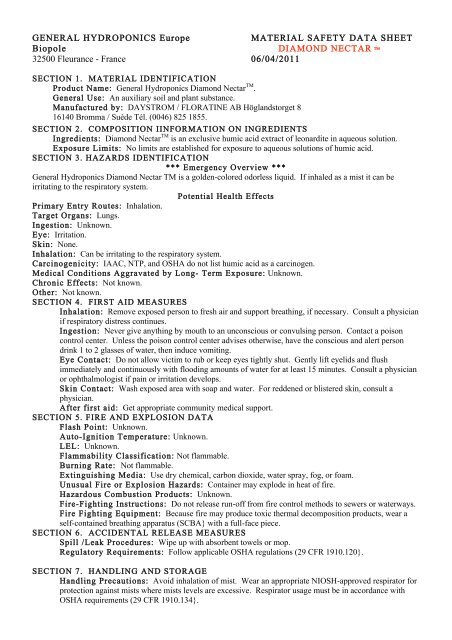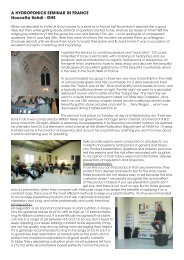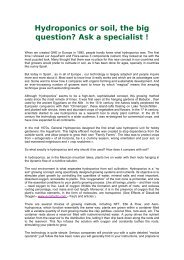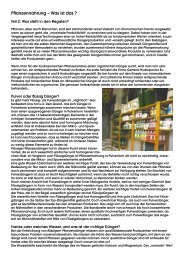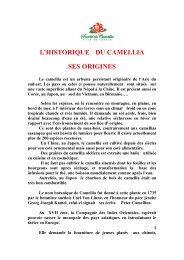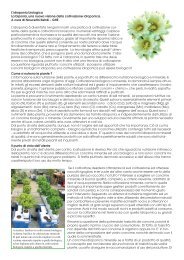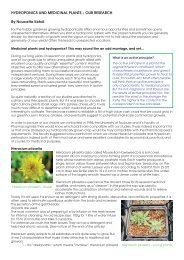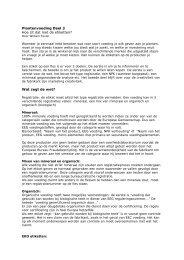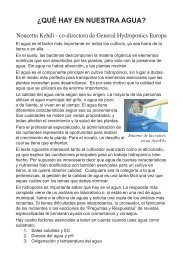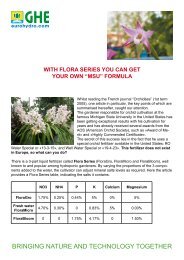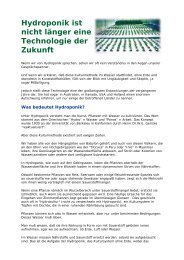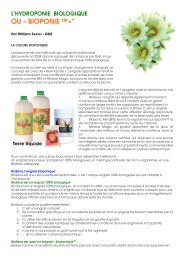Diamond nectar.pdf - General Hydroponics Europe
Diamond nectar.pdf - General Hydroponics Europe
Diamond nectar.pdf - General Hydroponics Europe
Create successful ePaper yourself
Turn your PDF publications into a flip-book with our unique Google optimized e-Paper software.
GENERAL HYDROPONICS <strong>Europe</strong> MATERIAL SAFETY DATA SHEET<br />
Biopole DIAMOND NECTAR <br />
32500 Fleurance - France 06/04/2011<br />
SECTION 1. MATERIAL IDENTIFICATION<br />
Product Name: <strong>General</strong> <strong>Hydroponics</strong> <strong>Diamond</strong> Nectar TM .<br />
<strong>General</strong> Use: An auxiliary soil and plant substance.<br />
Manufactured by: DAYSTROM / FLORATINE AB Höglandstorget 8<br />
16140 Bromma / Suède Tél. (0046) 825 1855.<br />
SECTION 2. COMPOSITION IINFORMATION ON INGREDIENTS<br />
Ingredients: <strong>Diamond</strong> Nectar TM is an exclusive humic acid extract of leonardite in aqueous solution.<br />
Exposure Limits: No limits are established for exposure to aqueous solutions of humic acid.<br />
SECTION 3. HAZARDS IDENTIFICATION<br />
*** Emergency Overview ***<br />
<strong>General</strong> <strong>Hydroponics</strong> <strong>Diamond</strong> Nectar TM is a golden-colored odorless liquid. If inhaled as a mist it can be<br />
irritating to the respiratory system.<br />
Potential Health Effects<br />
Primary Entry Routes: Inhalation.<br />
Target Organs: Lungs.<br />
Ingestion: Unknown.<br />
Eye: Irritation.<br />
Skin: None.<br />
Inhalation: Can be irritating to the respiratory system.<br />
Carcinogenicity: IAAC, NTP, and OSHA do not list humic acid as a carcinogen.<br />
Medical Conditions Aggravated by Long- Term Exposure: Unknown.<br />
Chronic Effects: Not known.<br />
Other: Not known.<br />
SECTION 4. FIRST AID MEASURES<br />
Inhalation: Remove exposed person to fresh air and support breathing, if necessary. Consult a physician<br />
if respiratory distress continues.<br />
Ingestion: Never give anything by mouth to an unconscious or convulsing person. Contact a poison<br />
control center. Unless the poison control center advises otherwise, have the conscious and alert person<br />
drink 1 to 2 glasses of water, then induce vomiting.<br />
Eye Contact: Do not allow victim to rub or keep eyes tightly shut. Gently lift eyelids and flush<br />
immediately and continuously with flooding amounts of water for at least 15 minutes. Consult a physician<br />
or ophthalmologist if pain or irritation develops.<br />
Skin Contact: Wash exposed area with soap and water. For reddened or blistered skin, consult a<br />
physician.<br />
After first aid: Get appropriate community medical support.<br />
SECTION 5. FIRE AND EXPLOSION DATA<br />
Flash Point: Unknown.<br />
Auto-Ignition Temperature: Unknown.<br />
LEL: Unknown.<br />
Flammability Classification: Not flammable.<br />
Burning Rate: Not flammable.<br />
Extinguishing Media: Use dry chemical, carbon dioxide, water spray, fog, or foam.<br />
Unusual Fire or Explosion Hazards: Container may explode in heat of fire.<br />
Hazardous Combustion Products: Unknown.<br />
Fire-Fighting Instructions: Do not release run-off from fire control methods to sewers or waterways.<br />
Fire Fighting Equipment: Because fire may produce toxic thermal decomposition products, wear a<br />
self-contained breathing apparatus (SCBA} with a full-face piece.<br />
SECTION 6. ACCIDENTAL RELEASE MEASURES<br />
Spill /Leak Procedures: Wipe up with absorbent towels or mop.<br />
Regulatory Requirements: Follow applicable OSHA regulations (29 CFR 1910.120}.<br />
SECTION 7. HANDLING AND STORAGE<br />
Handling Precautions: Avoid inhalation of mist. Wear an appropriate NIOSH-approved respirator for<br />
protection against mists where mists levels are excessive. Respirator usage must be in accordance with<br />
OSHA requirements (29 CFR 1910.134}.
Storage Requirements: No special requirements<br />
Regulatory Requirements: Follow applicable OSHA regulations.<br />
SECTION 8. EXPOSURE CONTROLS/PERSONAL PROTECTION<br />
Ventilation: Provide general or local exhaust ventilation systems to maintain airborne concentrations as<br />
low as possible.<br />
Administrative Controls: Avoid breathing mist.<br />
Respiratory Protection: If this product is used as directed, respiratory protection is not required.<br />
Seek professional advice prior to respirator selection and use. Follow OSHA respirator regulations (29<br />
CFR 1910.134) and, if necessary, wear a MSHA/ NIOSH-approved respirator. If respirators are used,<br />
OSHA requires a written respiratory protection program that includes, at least: medical certification,<br />
training, fit testing, periodic environmental monitoring, maintenance, inspection, cleaning, and convenient,<br />
sanitary storage areas.<br />
Protective Clothing/Equipment: No special clothing is required.<br />
Comments: Never eat, drink, or smoke in work areas. Practice good personal hygiene after using this<br />
material, especially before eating, drinking, smoking, using the toilet, or applying cosmetics.<br />
SECTION 9. PHYSICAL AND CHEMICAL PROPERTIES<br />
Physical State: Aqueous solution.<br />
Specific Gravity: 1.031.<br />
Appearance and Odor: Golden-colored liquid with no odor.<br />
pH: 5.21.<br />
Odor Threshold Range: Unknown.<br />
Vapor Pressure: 570.<br />
Water Solubility: Soluble.<br />
Other Solubilities: Unknown.<br />
Boiling Point: 100 ø C.<br />
Freezing Point / Viscosity: Unknown.<br />
SECTION 10. STABILITY AND REACTIVITY<br />
Stability: Stable at room temperature in closed containers, under normal storage and handling<br />
conditions.<br />
Polymerization: Hazardous polymerization cannot occur.<br />
Chemical Incompatibilities: Neutralization reaction will occur if exposed to alkaline materials.<br />
Conditions to Avoid: Inhalation of mist.<br />
Hazardous Decomposition Products: Unknown.<br />
SECTION 11. TOXICOLOGICAL INFORMATION<br />
Not believed to be toxic.<br />
SECTION 12. ECOLOGICAL INFORMATION<br />
Ecotoxicity: Unknown.<br />
Environmental Fate: Not expected to be significant.<br />
Environmental Degradation: Unknown.<br />
SECTION 13. DISPOSAL CONSIDERATIONS<br />
Waste Disposal: Follow Federal, State, and local regulations.<br />
SECTION 14. TRANSPORTATION INFORMATION<br />
DOT Transportation Data (49 CFR 172.101): Not listed.<br />
SECTION 15. REGULATORY INFORMATION<br />
EPA Regulations: Not listed.<br />
SECTION 16. OTHER INFORMATION<br />
<strong>General</strong> <strong>Hydroponics</strong> <strong>Diamond</strong> Nectar is a plant nutrition product. Information assembled for this Material<br />
Safety Data Sheet is for the use of this product as intended by the manufacturer. Users should take all<br />
precautions recommended herein while working with this product.<br />
<strong>General</strong> <strong>Hydroponics</strong> provides the information contained herein in good faith, but makes no representation<br />
as to its comprehensiveness or accuracy. This document is intended only as a guide to the appropriate<br />
precautionary handling of the material by a properly trained person using this product. Individuals<br />
receiving the information must exercise their independent judgment in using this product.


